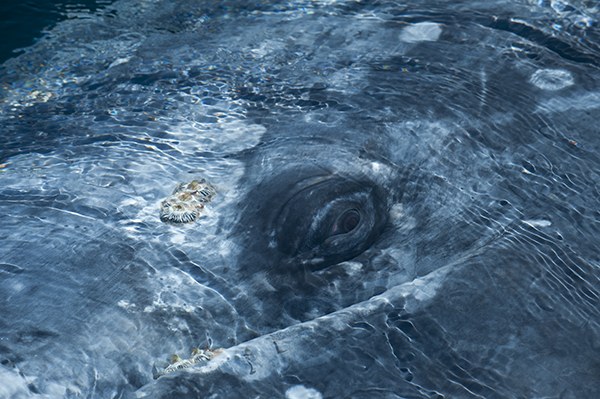
One of the stories from The Wild Edge that resonates strongly with me is from Baja California, of gray whales approaching boats and trusting people to touch their bodies and stroke their newborn calves. People who experience these intimate encounters with whales describe them as among the most stirring moments of their lives--a connection of heart and spirit.
I think many people who visit “their whales,” in the San Juan Islands, or from urban beaches all along the Pacific coast would admit they don’t often think about the epic migration: from remote lagoons in the southern Baja Peninsula of Mexico where they give birth to Arctic waters thousands of miles north, abundant with life upon which the whales rely. The gray whales that you spot off the coast depend on a healthy environment, not only as far as your eye can see, but along the entire coastline, from the southern Baja Peninsula to the northern Beaufort Sea of Alaska — from Baja to Beaufort.
Drilling for oil and dealing with the aftermath of a catastrophic spill along a seemingly remote Alaskan coast take on new meaning for Washington whale watchers when they learn that the Beaufort Sea is a biological hot spot where “their” whales migrate.
In The Wild Edge, we hope to convey the importance of key habitat preservation, and to present an audacious vision. Together with Florian Schulz and grassroots groups, our goal is to preserve vast natural and healthy corridors that connect these biological hot spots, from Baja to Beaufort. Life as we know it — life we depend on — will then have the freedom to roam and the greatest chance to adapt and thrive.
The gray whale is just one of many creatures to benefit from more thoughtful consideration and treatment. Among species that migrate along the Pacific coast are caribou, birds, salmon, and butterflies. Others — including humans — thrive in place along abundant, healthy coastlines.
A series of parks, preserves, and sanctuaries that are connected via protected wildlife corridors could be the salvation for all life — including human communities. To allow encroachments to continue into these lands and waters is unimaginable: rising levels of oceans are destroying coastal communities and ocean acidification is killing shellfish and destroying economies while throwing the entire food chain off balance.
It is possible to make a seismic difference in what kind of life we live now and leave to future generations. We can evolve by choice or by chance. By weaving what we know about the gray whale into a bigger story of profound interdependence, we can find reasons to behave differently for mutual benefit. We have the imagination to explore options, the heart to see beyond our own needs, and the technology and resources to change business as usual.
Our hope with this latest Braided River book and outreach campaign is that the artistry of Florian Schulz’s images and the collective voices and stories of this book will set fire to your passion and resolve. As a Mountaineer, you enjoy personal encounters with wildlife and wild places more often than most. We hope you will become another active supporter of protecting the last precious remaining natural wild places of beauty and diversity, helping to provide all life the freedom to roam — not only in your own backyard, but along the entire wild edge of the Pacific Coast.
Published by Braided River, the conservation imprint of Mountaineers Books, The Wild Edge: Freedom to Roam the Pacific Coast features photography by Florian Schulz and essays by Bruce Barcott, Eric Scigliano, Jon Hoekstra, Bonnie Henderson and an epilogue by Philippe Cousteau. Explore www.thewildedge.org to see a few of the gorgeous photos from the book.
This article originally appeared in our Winter 2016 issue of Mountaineer Magazine. To view the original article in magazine form and read more stories from our publication, click here.
 Helen Cherullo
Helen Cherullo